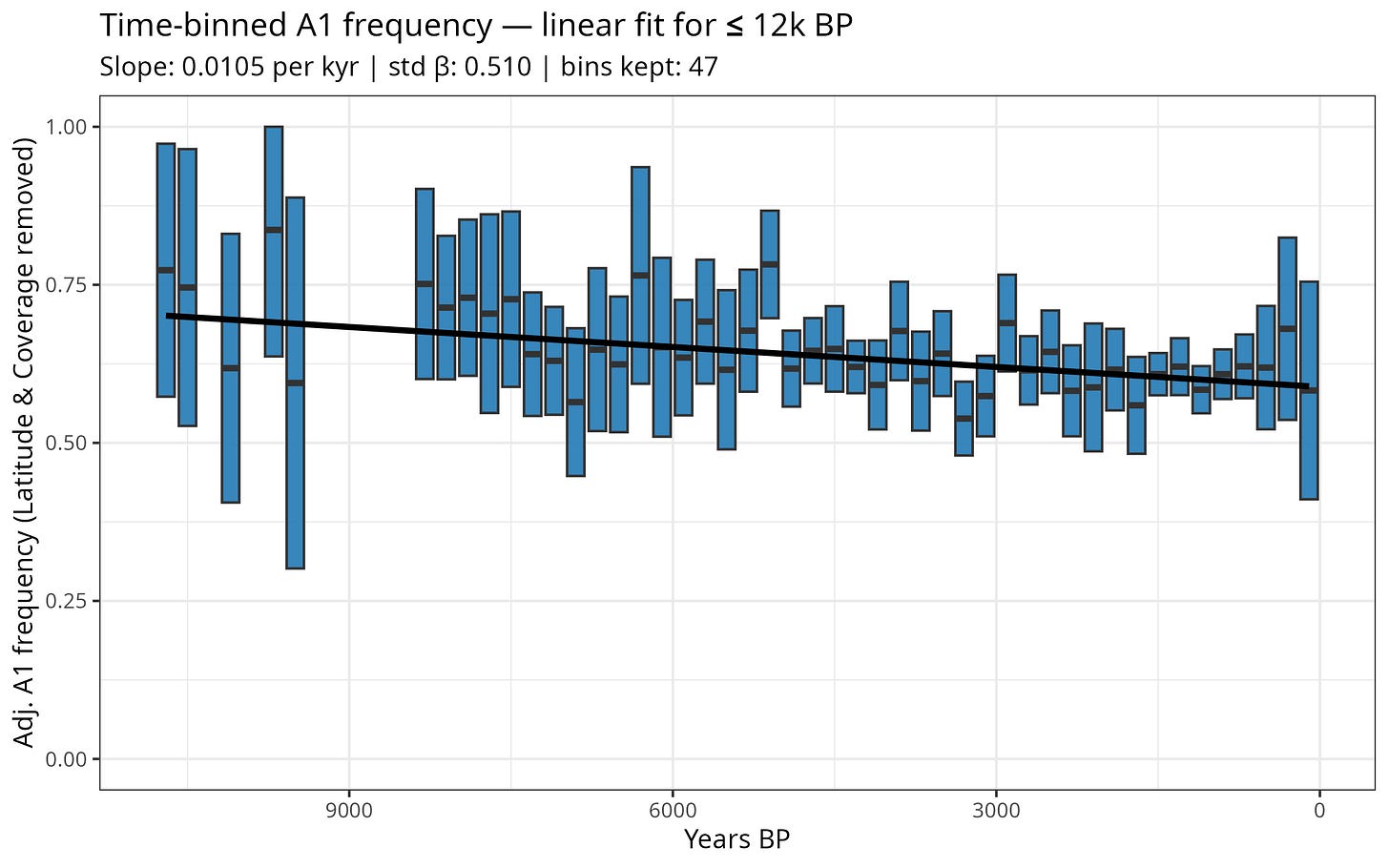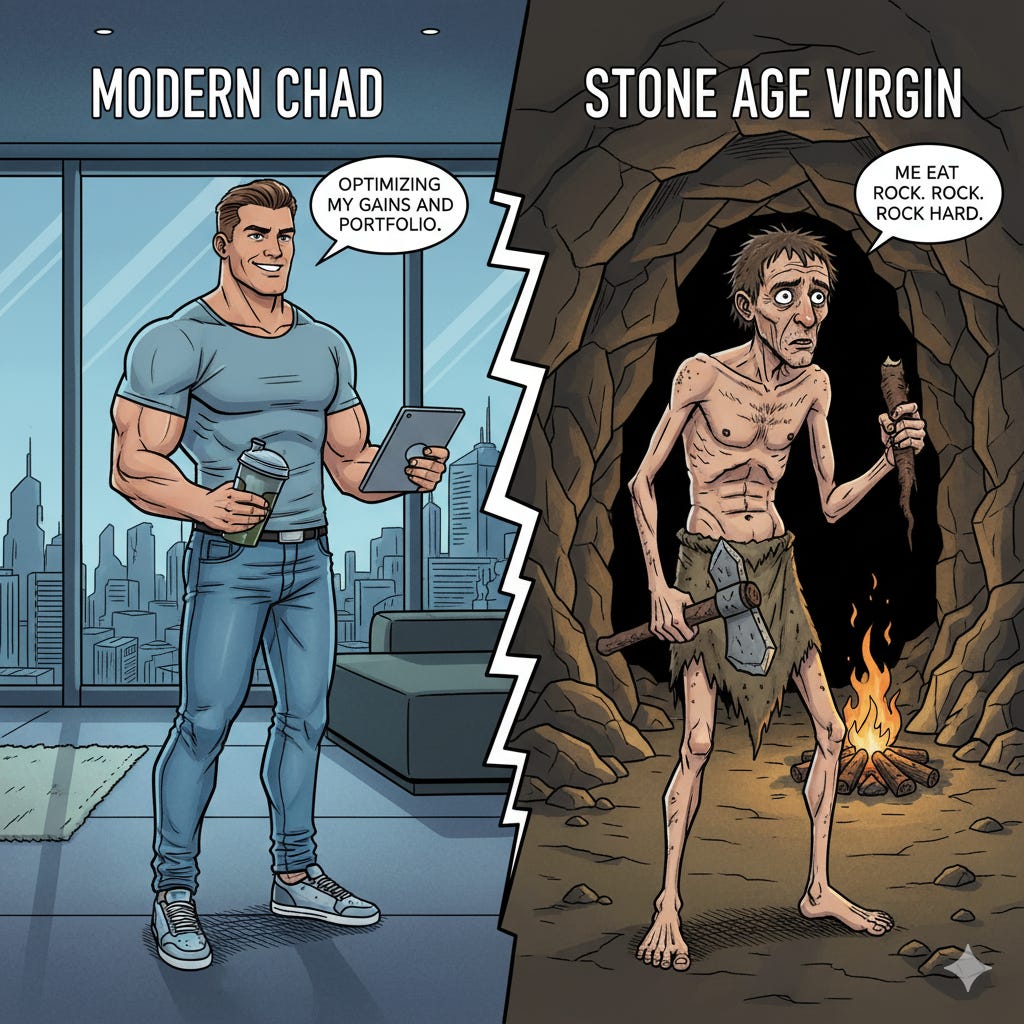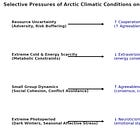Modern chads, virgin cavemen?
A 12,000-year time trend in a DNA variant linked to sexlessness
TL;DR: When we track the top genome-wide hit from Abdellaoui et al., 2025, its frequency declines toward the present across ancient Eurasian genomes. After adjusting for latitude and coverage and binning samples in 500-year windows ≤12k BP, a simple weighted regression shows a negative time trend (slope ≈ 0.0105 per kyr in “years BP” coordinates; i.e., higher in the deeper past, lower today). The standardized effect size on these binned means is β ≈ 0.51.
The story the DNA tells
If a genetic variant truly nudges people toward long-term sexlessness, and if that tendency reduces reproductive success, then natural selection should push that variant downward over generations.
That’s exactly the pattern we see in ancient DNA. Using thousands of individuals across West Eurasia spanning the Holocene, I focused on the lead SNP from the new GWAS of lifetime sexlessness by Abdellaoui et al. (2025). For each ancient individual I computed the A1 allele frequency (the allele identified in the paper as the positive-effect allele for sexlessness). I then:
Adjusted the per-individual frequencies to a common latitude and coverage (to minimize geographic and technical confounds).
Binned samples into 500-year time slices for the last 12k years (where sampling is dense and CIs are narrow).
Took the bin means ±95% CI, and fit a weighted linear model across bins.
Result: as we move from the deep past (right side of the x-axis, larger BP) toward the present (left), the bin means creep downward. Interpreted forward in time, that’s a gradual decline of the sexlessness-increasing allele.

Why this would make evolutionary sense
If the allele truly increases the chance of being sexless across adulthood, then—on average—it reduces expected offspring count.
Even a tiny selection coefficient compounded over hundreds of generations can reshape allele frequencies.
The Holocene also brought rapid cultural and demographic changes (sedentarization, social complexity, partner markets), any of which could amplify selection against traits that depress mating or partnering.
Discussion
What could this allele be doing?
We don’t (yet) know. The lead SNP from Abdellaoui et al. tags some causal signal by LD, but the biology could be anywhere along the regulatory cascade (brain development, socio-cognitive tendencies, psychiatric risk, energy balance, endocrine axes, etc.). A simple “low testosterone → less mating” story is probably too neat: Holocene testosterone ecology is murky, and the modern GWAS signal largely reflects behavioral and social outcomes in contemporary societies. A more plausible framing is neurobehavioral liability that nudges mating/partnering probabilities, which selection then trims very slowly.
An evolutionary paradox
The authors themselves note that the variables correlated with sexlessness cluster around a recognizable “nerdy” phenotype (higher IQ and education, thinner, less athletic, introverted, more autistic traits). Yet several ancient-DNA studies suggest long-run selection for education-related traits, which makes this look paradoxical.
A simple way to reconcile the patterns is to note that the correlation between sexlessness and IQ/education is far from perfect. We’re likely looking at a subset of alleles that both (i) nudge people toward sexlessness and (ii) overlap modestly with education/IQ architecture. Those alleles would have been selected against because they reduce partnering and reproduction. Meanwhile, the many other alleles that raise education or IQ without increasing sexlessness could have been selected for. Net effect: the education/IQ polygenic trend can rise over time even while a smaller “sexlessness-linked” subset declines. If anything, that means the increase in education/IQ polygenic scores might have been even larger in the absence of weak selection trimming the “nerdy” subset tied to reduced partnering.
This doesn’t mean prehistoric people were ‘nerdier.’ It means that one risk-increasing allele (and likely a small subset of related variants) was a bit more common long ago, and—because even tiny disadvantages in partnering add up over generations—it drifted down, while the much larger set of education/IQ-raising variants could rise.
Suppose in earlier societies extraversion was strongly positive for partnering and fertility (more courtship, wider social networks), while its genetic overlap with IQ was weakly negative or near-zero. Then selection favoring extraversion would raise the extraversion PGS and, via any small negative overlap, only slightly tug down the education/IQ architecture. Net effect: the education/IQ PGS still rises, but a small subset of alleles tied to sexlessness (and lower extraversion) is trimmed. In other words, selection for higher extraversion could have boosted its own polygenic score more than it depressed the education/IQ score—leaving us with exactly what we observe: a long-run decline in the sexlessness-linked allele alongside an overall upward trend in education/IQ signals.
As I showed in
there is evidence for an increase in Extraversion PGS over the last 12K years.
Why do so many traits show up as “related” to sexlessness genetics?
Abdellaoui et al. report genetic correlations with things like strength (men), IQ, education, ADHD (negative), autism, introversion, etc. That sounds like one SNP doing everything, but that’s not what the statistic means.
Key point: those correlations are not computed from polygenic scores. They are estimated from GWAS summary statistics via LD Score regression (LDSC).
Within-trait LDSC regresses each SNP’s χ2 on its LD score (the amount of LD it has with nearby variants) to estimate SNP-heritability while absorbing confounding from polygenicity and sample structure.
Cross-trait (bivariate) LDSC regresses the product of Z-scores for trait 1 and trait 2 on the LD score. The slope, scaled by sample sizes, gives genetic correlation rg—the extent to which the same sets of variants affect both traits.
Crucially, this uses GWAS summary stats only, not individual data and not PGS; it’s robust to sample overlap and doesn’t require choosing a P-value threshold.
What the time trend means—and doesn’t
The decline of the risk-increasing allele over the last ~12 ky is consistent with weak negative selection on traits that reduce partnering and reproduction. That’s an evolutionary story that matches intuition. But it’s a population-level, polygenic story: this one variant is a tracer. Until we map the causal variant(s) and their regulatory targets—and reconcile the web of genetic correlations—we should read the trend as evidence of selection on a behaviorally mediated liability, not as proof of a specific hormonal or anatomical pathway.
Important caveats (read these!)
One SNP ≠ destiny. This is a single lead variant from a polygenic trait; the whole genetic architecture matters. Unfortunately, the GWAS produced only this significant hit.
Sampling & uncertainty. Very ancient bins are sparse; we therefore restricted the regression to ≤12k BP where sample density supports tighter CIs.
Confounding. I controlled for latitude and coverage, but residual population structure or temporal sampling biases may remain.
Selection vs. drift. A declining trend is consistent with selection but is not a proof; demographic history (founder events, admixture) can also move frequencies.
References
A. Abdellaoui, L.W. Wesseldijk, S.D. Gordon, J.A. Pasman, D.J.A. Smit, R. Androvičová, N.G. Martin, F. Ullén, M.A. Mosing, B.P. Zietsch, & K.J.H. Verweij, Life without sex: Large-scale study links sexlessness to physical, cognitive, and personality traits, socioecological factors, and DNA, Proc. Natl. Acad. Sci. U.S.A. 122 (38) e2418257122, https://doi.org/10.1073/pnas.2418257122 (2025).



